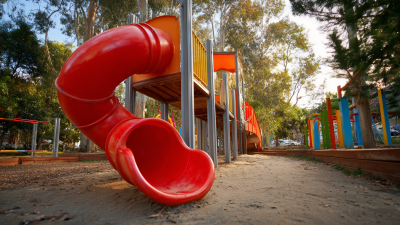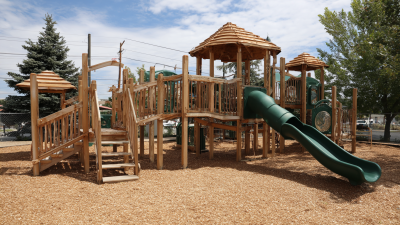 +86-13901441113
+86-13901441113




Choosing the perfect Outdoor Play Slide for your child can be a rewarding yet challenging task, especially in today's market filled with various options and safety standards. According to the American Society for Testing and Materials (ASTM), over 200,000 children visit the emergency room each year due to injuries associated with playground equipment, highlighting the importance of safety when selecting an Outdoor Play Slide. Furthermore, a recent National Program for Playground Safety report notes that more than 70% of playground accidents could be avoided with proper equipment and installation. This underscores the necessity of not only considering the slide's fun factor but also its safety features, material quality, and age appropriateness. In this guide, we will explore expert tips to help parents navigate these factors, ensuring a safe and enjoyable outdoor play experience for their children.

When selecting the perfect outdoor play slide, it's essential to understand the various types available and their unique features. Slides can generally be categorized into several styles, including straight slides, spiral slides, and wave slides.
 Straight slides offer straightforward fun and are ideal for younger children, while spiral slides provide a thrilling ride with twists and turns that appeal to slightly older kids. Wave slides introduce gentle undulations, making them both fun and visually engaging.
Straight slides offer straightforward fun and are ideal for younger children, while spiral slides provide a thrilling ride with twists and turns that appeal to slightly older kids. Wave slides introduce gentle undulations, making them both fun and visually engaging.
Safety is a crucial factor when choosing a slide. Look for slides made from durable materials that can withstand weather conditions. Additionally, the height of the slide is vital; lower slides are safer for toddlers, while taller slides are suitable for older children. Features like sidewalls and safety handles can enhance security.
Furthermore, check for certifications from safety organizations, ensuring the slide meets proper safety standards for outdoor use. Understanding these different types and their features will help parents make an informed decision and provide a safe, enjoyable experience for their children.
When choosing an outdoor play slide, safety should always be the paramount consideration. One essential aspect is the material used in the slide's construction. High-quality, durable materials like high-density polyethylene are preferable because they are not only sturdy but also resistant to weather conditions. Avoid slides with sharp edges or rough seams, as these can pose injury risks to children. Additionally, ensure the slide complies with safety standards set by organizations such as ASTM International, which provides guidelines for manufacturing children's playground equipment.
Another crucial factor to consider is the slide's design and height. Slides that are too steep or high can increase the risk of falls, particularly for younger children who may not have developed the necessary balance and coordination. Additionally, look for a slide with a gradual incline and raised sides to provide extra security while children are playing. It's also important to assess the area surrounding the slide; a soft landing surface, such as rubber mulch or grass, can significantly reduce the risk of injury in the event of a fall. By prioritizing these safety considerations, you can create a safer outdoor play environment for children to enjoy.
When choosing the perfect outdoor play slide, it’s crucial to evaluate the material and construction quality to ensure durability and safety. High-quality materials such as reinforced plastics, fiberglass, and weather-resistant metals are pivotal in withstanding outdoor conditions. These materials not only ensure longevity but also contribute to a smoother surface that enhances user safety during play. Incorporating features like non-slip textures can further minimize the risk of falls.
In addition to material assessment, understanding construction quality is essential. Just as advancements in construction materials, such as sustainable and circular materials, have emerged in building practices, similar innovations are applicable to outdoor equipment. For instance, utilizing composites designed for 3D printing can lead to intricate designs that prioritize both aesthetics and resilience. Evaluating the manufacturing processes ensures that the slide meets safety regulations while supporting environmental sustainability, fostering a safer and more responsible approach to children's outdoor play equipment.
| Dimension | Material | Durability Rating | Safety Standard Compliance | Average Lifespan (Years) |
|---|---|---|---|---|
| 5 ft slide | Polyethylene | 4/5 | ASTM F2373 | 10 |
| 7 ft slide | Fiberglass | 5/5 | EN 1176 | 15 |
| 3 ft slide | Plastic | 3/5 | CPSC | 5 |
| 6 ft slide | Metal | 4.5/5 | ASTM F1487 | 12 |
| 4 ft slide | Recycled Plastic | 4/5 | ASTM F963 | 8 |
When selecting an outdoor play slide for your child, the size and height are crucial factors to consider based on their age and skill level. For younger children, such as toddlers aged 1 to 3 years, a low slide with an incline of no more than 3 feet is ideal. This height provides a safe and manageable experience as they develop their climbing and sliding skills. Look for slides designed specifically for younger age groups, featuring gentle slopes and wider bases for stability.
As children grow and develop more confidence in their abilities, they may be ready to transition to taller slides. For preschoolers aged 4 to 6, slides that reach 4 to 6 feet high can offer additional excitement, but it’s important to ensure that they can navigate the slide easily and safely. Parents should always supervise their children during play and encourage playtime among peers to promote social skills. Make sure that the slide is made of durable materials that can withstand rough play while having appropriate safety features, such as rounded edges and a sturdy ladder. Properly assessing your child's size and skill level will help in choosing a slide that not only entertains but also keeps them safe.
When it comes to installing an outdoor play slide, safety should be your top priority. One of the most critical tips is to ensure that the slide is placed on a soft, even surface. Consider using materials like grass, mulch, or rubber mats to cushion falls. This can significantly reduce the risk of injuries. Furthermore, check for a safe clearance zone around the slide, keeping it free from obstacles and ensuring there’s ample space for users to slide off safely.

Regular maintenance is also essential to prolong the life of your outdoor play slide and keep it safe for children. Inspect the slide for any visible wear and tear, such as cracks or sharp edges, which can pose hazards. Additionally, make sure to tighten any loose bolts or screws. This not only enhances the slide’s stability but also ensures a safe play environment. Incorporating these tips will help create a fun yet secure outdoor play area for children.





